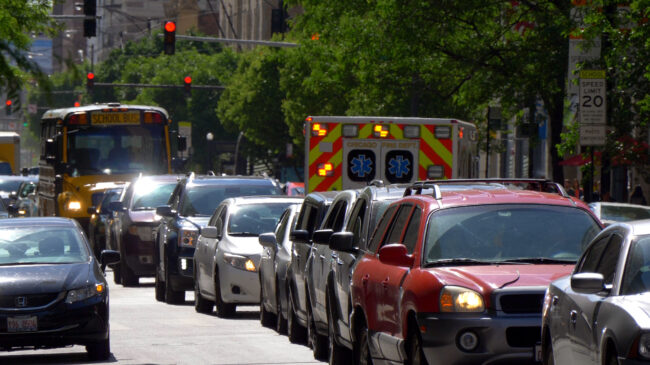Due to an increase in traffic fatalities in 2021, many U.S. cities have begun looking for answers to what the Centers for Disease Control and Prevention has dubbed a “public health concern.”
One increasingly popular approach to addressing the spike in traffic-related deaths has been adopting a Vision Zero (VZ) program. The concept originated in Sweden in 1997 and sets a goal of zero traffic fatalities and serious injuries. VZ was adopted by Chicago in 2012, San Francisco in 2014, and Los Angeles in 2015. However, the success of VZ has been uneven at best and the superior approach for lower traffic fatalities lies in data-gathering, local partnerships, community education, and re-engineering when necessary.
For cities, zero traffic fatalities and serious injuries are not obtainable short or long-term goals. The VZ approach calls for discarding cost-benefit analysis and the “whack-a-mole” approach of fixing one intersection at a time. Instead, it calls for making sweeping changes to all of a city’s High Injury Network (HIN), defined as areas where fatalities are disproportionately high. Claiming that no price can be placed on human life is a noble approach, but one that is unrealistic in a world where policymakers have limited resources to solve problems.
Efforts to reduce traffic fatality rates in the last 10 years have varied, making it hard to label what exactly constitutes a VZ program. Examples of VZ measures that cities have taken to reduce fatalities include:
- requiring safety skirts on the side of the street;
- adding buffer zones between bike lanes and traffic lanes, often narrowing or outright removing a travel lane in the process;
- closing travel lanes during peak hours;
- identifying locations with possible conflicts between pedestrians and cars to lessen injury severity.
Many of VZ’s proposed changes, such as limiting lane use during peak hours, would slow traffic and worsen conditions for drivers and lower-income commuters in these cities. By increasing the duration of commutes, and making some people late for work, cities inadvertently reduce the economic well-being of lower-income people. Instead of making roads worse for drivers, the goal should be to make them safer and more efficient for everyone involved—be they a driver, a cyclist, or a pedestrian.
As noted, several U.S. cities have adopted VZ plans. In 2012, Chicago launched its program with then-Mayor Rahm Emanuel stating a goal of “zero traffic deaths by 2022.” The city’s approach was outlined in a 100-page Action Agenda, which was little more than a statement of principles. Five years later, the city started work on VZ implementation and reset the 10-year counter from 2022 to 2027. Chicago aimed to improve some “300 intersections to make them safer for pedestrians.”
In September 2019, Chicago Mayor Lori Lightfoot announced that $6 million was being allocated to their West Side VZ plan, a stark difference from a statement she made as a candidate when she said she would, “reallocate $20 million from existing Chicago Department of Transportation funding” towards VZ projects. For a city frequently finding itself short on funds, especially for projects this transformative and wide in scope, VZ’s costly approach makes little sense. Even after all of that money was allocated, Chicago’s 2020 traffic fatality rates remained about the same as in 2012, before VZ was implemented.
In 2014, San Francisco announced and implemented its own VZ program. The program, which has been relatively successful in reducing traffic deaths, began with a comprehensive push for more accountability and better data-gathering to help paint a clearer picture for policymakers looking to address traffic fatalities. With San Francisco’s clearly defined HIN and the city’s Quick-Build program, San Francisco was able to make changes relatively quickly and cheaply. San Francisco’s fatalities decreased significantly in 2019 and 2020. Overall, San Francisco has been more successful than other major cities in lowering fatalities but recreating the city’s success may be more difficult in more automobile-reliant cities.
Los Angeles’ VZ program was started in 2015 and has been the least effective at reducing fatalities. In 2016, Los Angeles’ pedestrian death rate “was twice that of San Francisco, Chicago, and New York, and four times that of Seattle,” per Bloomberg. In the three years following VZ adoption, pedestrian fatalities increased by 75%. Things didn’t look good for drivers either: In 2017, Los Angeles ranked as the “most congested city in the world”, the sixth year in a row it received that ranking. Conditions for drivers were already nightmarish, with drivers spending hours upon hours in congestion, but fatalities remained high on top of those conditions.
Los Angeles did implement some changes such as exclusive pedestrian traffic signal phases which halt all vehicular traffic for a time as a means of lowering fatalities. While fatalities have been decreasing, they are still above the 2015 numbers when the program started.
Most VZ policies in the U.S. have been expensive failures, with negligible effects on overall traffic fatalities. Outliers such as San Francisco have a few advantages that made a VZ approach more realistic – namely less reliance on driving to commute. In San Francisco in 2018, 40.2% of people drove to work whereas in Los Angeles in 2015 nearly 80% drove alone and 10% carpooled, and 77.4% of Chicagoans in 2018 relied on automobiles for their commute.
While auto-averse solutions may work in cities that are not so reliant on cars (like San Francisco), making conditions worse for drivers in cities like Los Angeles and Chicago is often met with political pushback. In Los Angeles, for example, drivers are already spending massive amounts of time in slow-moving traffic. Some streets need to keep their higher speeds to allow for a shorter, more efficient commute through cities.
To reduce traffic fatalities more effectively, cities should begin with detailed analyses of their high-injury networks instead of heavy-handed reform for every part of the road system. In Orlando, drivers were failing to yield to pedestrians at crosswalks. Following a partnership with local law enforcement, officers started issuing warnings near crosswalks during a three-month enforcement period. It was determined that a few low-cost engineering solutions would be sufficient: moving yield signs 30 feet, adding medians and refuge islands, and some other changes. Following two rounds of enforcement and re-engineering, driver yield rates went from 5% to 28% for a price far lower than most VZ projects.
Cities do not need to take the Vision Zero all-or-nothing approach when a more customizable set of solutions is available.

